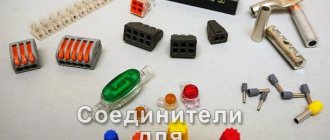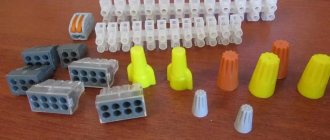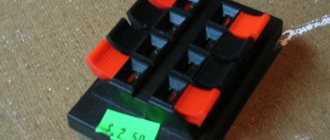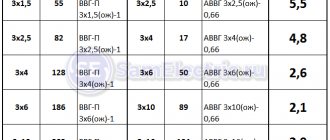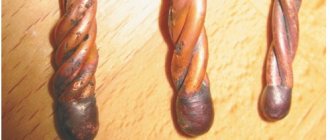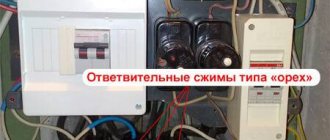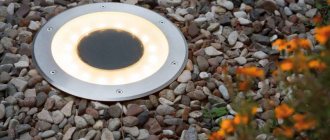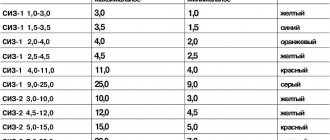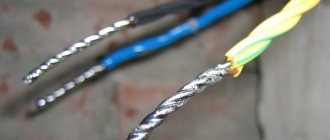Maintenance of electrical networks inevitably involves work with terminals for electricians. This is a kind of small mounting hardware, the use of which is difficult to do without when connecting wires to each other or to electrical equipment.
Time has eliminated outdated terminals for connecting wires from practice, but is steadily supplementing the base of electrical engineering with new developments - more advanced ones.
We will help you understand the variety of electrical accessories. The article discusses different types of terminal blocks and describes their application and installation features.
When to connect cables
Cable connections will be required in case of poor-quality wiring performed earlier, or due to errors made during installation work. To restore power to the house, you need to connect the electrical wires. You can make a connection in ways that are divided into 2 groups:
- For the first group, no special equipment is required.
- The second group already requires certain skills and professional tools.
Work on connecting cables must be carried out in compliance with safety regulations.
Welding
In order for the connection of electrical wires to be as reliable as possible, the considered twisting method must be subsequently secured by welding. It is similar to soldering, only now a welding machine is used instead of a soldering iron.
Positive sides
This method is most preferable to all others, since it meets all regulatory requirements in terms of reliability and quality.
The welding method is based on contact heating of the ends of the wires with a carbon electrode until a ball (contact point) is formed. This ball is obtained as a single unit from the fused ends of all connected cores, which ensures safe and reliable contact; it will not weaken or oxidize over time.
Negative sides
The disadvantage of welding is that such work requires certain knowledge, experience, skills and special equipment; you often have to turn to specialists.
Installation
In order to connect wires using welding, you will need the following devices, tools and materials:
- welding inverter with a power of at least 1 kW, its output voltage must be up to 24 V;
- carbon or graphite electrode;
- goggles or eye mask;
- welding leather gloves to protect hands;
- a mechanic's knife or stripper for removing the insulating layer from conductors;
- sandpaper (for cleaning the conductive surfaces to be connected);
- insulating tape for further insulation of the welding joint.
The sequence of work is as follows:
- Free each connected wire from 60-70 mm of insulation.
- Sand the exposed wires until they are shiny using sandpaper.
- Twist, after biting, the length of its ends should be at least 50 mm.
- Attach grounding clamps to the top of the twist.
- To ignite the arc, bring the electrode to the bottom of the twist and lightly touch the connected wires with it. Welding happens very quickly.
- It turns out to be a contact ball, give it time to cool, and then insulate it with tape.
As a result, an almost solid wire is obtained at the end, that is, the contact will have the lowest transition resistance.
If you connect copper wires in this way, then choose a carbon-copper electrode.
I would like to recommend that if you purchase a welding machine (it will be useful not only for connecting wires, but also for many other purposes), then choose the inverter option. With small dimensions, weight and electrical energy consumption, it has a wide range of welding current adjustment and produces a stable welding arc
And this is very important to be able to regulate the welding current. If you choose it correctly, the electrode will not stick and the arc will hold steady.
Watch how welding is done in this video:
We looked at the main types of wire connections. Now let’s briefly talk about methods that are used less frequently, but also guarantee quality and reliability.
Types of cables for connection
The most common cable for home electrical wiring is a PVA connecting cable, consisting of two insulating layers.
Copper strands, stranded, twisted along the central axis. The wire is flexible, making it great for a variety of connections. The voltage of connected devices must be up to 380 Volts. The cross section is selected depending on the load:
- for a current of 6 A, PVA with a cross section of 0.75 mm is used;
- for 10 Amperes - the cross-section is 1 mm;
- for currents of 16 A – 1.5 mm.
In addition to the PVS wire, for connection there are multi-core cables ShVVP, PUGNP, PRS, KG. They are used less frequently for home wiring than PVS.
Wire Mounting Clamps
Let's move on to the second type of clamps, which are necessary when installing electrical networks. If the previously discussed options are used for switching conductors, then everything that will be presented in this chapter is used for fixing wires.
Linear tension wire clamp
All clamps that are used to secure cables and wires are divided into supporting ones (they are suspended on intermediate supports) and tension ones, which are held on anchor-type supports.
Clamps are also divided according to strength:
Clamps for linear wires are blind
- Blind - the strength of the sealing of these devices varies from 30 to 90% of the strength of aluminum wires or 10-15% of steel cables. If there is a break on one of the spans, the wire does not jump out of the clamp, but the tension from it is transferred to the support. This type is the most common when installing overhead power lines.
- Drop-out or releasing - they throw out a boat with a wire when the support garland is deflected at an angle of about 40 degrees, which ensures that there is no additional pressure on the support and a reduction in its mass. Today they are not used due to frequent cases of spontaneous ejection.
- Multi-roller - in fact, this is not quite a clamp, since the wire inside them rolls over the rollers, depending on the tension force in the adjacent spans.
- Pressed tension type clamps – This is a steel anchor in which the wire is pressed.
Wire clamp on pole
- Wedge clamp - consists of three metal parts: a base, a wedge and a pressure plate. When the wire is tensioned, it is held in place due to the high friction force. The parts wedge into each other.
In particular, the last version of the clamp can be installed with your own hands. The option shown in the photo above is used for fastening low-voltage wires and optical communication cables.
Basic requirements for terminal blocks for connecting wires
Various types of terminals
Electrical installation products are manufactured according to special standards and regulations. There are several requirements for terminal connectors:
- Resistant to high temperature and combustion. Materials used for the housing are self-extinguishing upon fire. Polyamide is recommended and is used by WAGO and Legrand.
- Reliable and fast fixation of contacts. It is recommended to leave sufficient cable length for communication to avoid tension.
- The properties of the clamps should not change during the period of operation.
- The size of the contact plates should prevent contact between cores of different materials. To ensure low resistance, copper and brass parts are coated with a special paste.
- Information about the main characteristics of the device is printed on the product body.
One of the essential requirements is protection against accidental access.
Scotchlock
For telecommunication systems, it is most convenient to use adhesive tape. This device is made of plastic and has metal contacts inside. The adhesive tape connector provides a high level of insulation. Without a soldering iron, without twisting, the wires are clamped by the device. The connection is provided with good insulation and protection from moisture. The main thing with this method is not to forget to take into account the cross-sectional diameter of the wire.
Advantages and disadvantages of terminal switching
Using terminals, you can connect copper and aluminum wires.
To connect a power cable on the street or in the house, the simplest option is to use connecting terminals for leads. Main advantages of the method:
- constructive variety of connectors;
- possibility of dismantling and repair;
- simplicity, speed and accessibility of installation;
- electrical safety, dielectric housing protects against electric shock;
- resistance to mechanical load and vibration;
- possibility of switching metal conductors of different sections and materials.
Flaws:
- allocation of additional space in panels and distribution boxes;
- high cost for large-scale work.
Electrical clamps are durable and reliable; to install them, you only need a screwdriver.
Spring type terminal blocks
The most common terminal blocks of this type are self-clamping terminal blocks from WAGO.
The WAGO series is available in 2 versions:
- PUSH WIRE (one-piece disposable).
- CAGE CLAMP (reusable).
It is impossible to remove the conductor from disposable terminals without damaging the terminal block. Reusable ones have a convenient lever to release the conductor.
This equipment is widely used not only in industrial production, but also in domestic conditions. They are especially popular for lighting networks.
The clamping occurs using a steel spring coated with a special chromium-nickel alloy. The complex shaped spring provides a reliable, durable connection. The housing, made of polycarbonate or polyamide, can withstand a wide range of temperatures and is resistant to aggressive environments.
The terminal blocks themselves are made of tinned copper. This significantly increases the contact patch, reduces contact resistance, and protects against corrosion. In addition, WAGO can be filled with a special lubricant that provides additional protection against corrosion.
model WAGO
WAGO is capable of connecting 2-8 conductors with a diameter of 0.5-4mm2. They are designed for a nominal voltage of 220V and a current of 32A.
All spring springs come in 2 versions - for DIN rail and standard version.
DIN-rail terminal blocks are used in control panels, control cabinets, and distribution boxes. They are used wherever there is increased vibration (for example, engineering, railway industry).
Phoniexcontact produces terminal blocks for DIN rails, designed for wires both with and without lugs with a cross-section of up to 35mm2. It is possible to connect up to 50 wires simultaneously.
The main advantage of Phoniexcontact equipment is its versatility. You can make any assemblies. All elements fit together easily.
Installation is extremely simple and accessible:
- First you need to prepare the conductor - strip the insulation by about 10-13mm.
- To connect the wire, just open the clamp using a regular screwdriver, insert the conductor and remove the screwdriver. The contact will close automatically.
Advantages of spring connections:
- Availability of a separate socket for each conductor.
- Durable, high-quality connection.
- Low contact resistance.
- Possibility of joining wires from different materials.
- Protection against corrosion , as well as other external influences.
- special tools required
- No special skills required .
- Possibility of reusable use.
- Does not require annual maintenance.
- Vibration resistance
- Free access for measuring tools.
- Potential distribution (if necessary) using jumpers.
The disadvantages include low permissible currents.
In addition to such well-known brands as WAGO, Phoniexcontact, similar equipment is produced by Legrand and ABB.
Table:
| Manufacturer | Type | Characteristics | Price, rub |
| WAGO | 222-412 | 2x0.08 – 4mm2, 32A, copper | 15,80 |
| WAGO | 222-415 | 5x0.08 – 4mm2, 32A, copper | 31,50 |
| WAGO | 273-248 | 8x0.5-2.5 mm2, 24A, copper/aluminum with Alu-Plus paste | 21,70 |
| WAGO | 273-503 | 3x1.5-4 mm2, 32-24A. copper/aluminum | 34,10 |
| Phoenixcontact | ST 1.5 – 3031076 | Feedthrough, 0.08-1.5mm2, AWG 28 – 16, Width: 4.2 mm, 17.5 A | 22.97 |
| Phoenixcontact | SP 2.5/ 1-L 3043019 | Plug-in, 1 pole, 0.08 mm2 – 4 mm2, AWG: 28 – 12, Width: 5.2 mm, Height: 39 mm, 24A | 91.59 |
How to choose the right terminals for wires
Before purchasing wire connection terminals, you need to research the power cable. You will need the following information:
- section;
- number of cores;
- conductor material.
An important criterion is the rated current. This characteristic is indicated by the manufacturer. If it is insufficient, the connector will begin to heat up and melt. The material of the case matters. For household appliances, sockets and switches, products made of polypropylene and polyamide are suitable. It is recommended to install ceramic devices in power buses. The last criterion is terminal size. It should be compact to fit in limited space.
Wago
The next type is Wago terminal blocks.
They also come in different sizes, and for different numbers of connected wires - two, three, five, eight. They can connect both monocores and stranded wires together.
For stranded ones, the clamp must have a latch-flag, which, when open, easily allows you to insert the wire and clamp it inside after latching.
According to the manufacturer, these terminal blocks in home wiring can easily withstand loads of up to 24A (lights, sockets).
There are some compact specimens also available for 32A-41A.
Here are the most popular types of Wago clamps, their markings, characteristics and what cross-section they are designed for:
There is also an industrial series for cable cross-sections up to 95mm2. Their terminals are really large, but the principle of operation is almost the same as that of small ones.
When you measure the load on such terminals, with a current value of more than 200A, and at the same time you see that nothing is burning or heating, many doubts about Wago products disappear.
If you have original Vago clamps, and not a Chinese counterfeit, and the line is protected by a circuit breaker with a correctly selected setting, then this type of connection can rightfully be called the simplest, most modern and convenient to install.
Violate any of the above conditions and the result will be quite natural.
Therefore, there is no need to install wago at 24A and at the same time protect such wiring with a 25A automatic. In this case, the contact will burn out if overloaded.
Always choose the right terminal blocks for your car.
As a rule, you already have automatic machines, and they primarily protect the electrical wiring, and not the load and the end consumer.
ZVI
There is also a fairly old type of connection, such as terminal blocks. ZVI – insulated screw clamp.
In appearance, this is a very simple screw connection of wires to each other. Again, it comes in different sections and different shapes.
Here are their technical characteristics (current, cross-section, dimensions, screw torque):
However, ZVI has a number of significant disadvantages, due to which it cannot be called the most successful and reliable connection.
Basically, you can only connect two wires to each other in this way. Unless, of course, you specifically choose large pads and shove several wires there. What to do is not recommended.
This screw connection works well for monocores, but not for stranded flexible wires.
For flexible wires, you will have to press them with NShVI lugs and incur additional costs.
You can find videos online where, as an experiment, transition resistances on different types of connections are measured with a microohmmeter.
Surprisingly, the lowest value is obtained for screw terminals.
Types of electrical connection blocks
Devices for switching wiring are selected depending on the purpose. Among the many models, the best option is selected. There are several ways to fix conductors in blocks.
Spring
Spring terminal design
A common version of spring-type products is self-clamping terminals. They are disposable and reusable. In the first case, after fastening, the wire cannot be pulled out without significant damage. In reusable models, it is released using a lever. Advantages of the method:
- installation does not require experience or tools;
- the stripped end of the wire is fixed with a spring after insertion into the groove;
- The connection is reliable and durable.
Spring-loaded copper contact plates secure stranded wires without damage. The quality of the wiring connection does not depend on the professionalism of the technician. Even a beginner can easily handle the self-clamping mechanism. The leader in the production of devices with automatic contact clamping is the German company WAGO. The disadvantage is the high cost of the products.
Screw
Screw
Terminal Screw terminals hold the wire to the terminal pad using screw pressure. The metal clamp is housed in a plastic housing. Advantages of switches:
- possibility of reuse;
- the block consists of many parts;
- installation is carried out with one screwdriver.
Disadvantages of screw pads:
- sensitivity to vibration;
- not recommended for aluminum cable;
- Regular maintenance (tightening of screws) is required.
Screw type terminal blocks are not suitable for multi-core wires. It is recommended for single-core copper cable. When tightening the screws, a certain amount of force is required; experience is required to perform the connections correctly. Well-known manufacturers of screw switches are Legrand and Wiedmuller.
Knife type
Knife-type
terminal Knife-type switches are installed in the circuits of the grounding system. They are recommended in areas where the wire is not cut for safety reasons. Their feature is that there is no need to remove insulation from the contact. The wire is inserted into the terminal block, where a special knife cuts through the braid and securely fixes the core. This type of connector has its advantages:
- installation is accelerated;
- compact dimensions;
- No professional skills required for installation.
Knife terminal blocks are not used for power circuits; most often they are used to connect audio equipment.
Terminals on plastic blocks
The terminals are used to connect two wires. They come with different hole diameters for the conductive core. The devices allow you to connect cables with one or more cores, conductors of various cross-sections. The design of the pads eliminates oxidation processes when connecting wires made of copper and aluminum. Some models are filled with a paste that prevents corrosion. A special recess in the plastic prevents pressure on the core when tightening the screw. The transparent body of the products makes it possible to assess the condition of the contacts.
Walnut Branch Clamps
Nut for connecting wires
The main branch branch clamp without separation consists of a plastic body and metal plates with bolts. The dies have grooves for contacts. When choosing a model, take into account the cross-section of the main wire and branches. This connector can be used to connect aluminum and copper wires. Between the two dies there is a brass separating plate.
For distribution boxes
The wires of all connected devices are brought into the distribution box. Terminal blocks for junction boxes are designed for branching electrical wiring. Their body is made of polycarbonate, and the contact pad is made of copper. Fixation is carried out by a spring mechanism.
With fuse
The devices have an additional element in their design - a fuse. The terminals are oversized. They are installed in DC and AC networks. Scope of application – switching electrical appliances without built-in fuses and installation in a panel on a DIN rail.
Spring varieties
Connecting wires using spring-type clamps is used for both simple and complex circuits. For several pairs of wires, a special block modification is made.
Fixation occurs due to straightening of the spring mechanism. This mount is considered one of the most reliable. This mechanism includes a special lubricant. It differs from previous materials that are used in fasteners. This is not a gel, but a lubricant of a certain consistency.
When producing spring-type terminals, manufacturers indicate the scope of application of such products. Clamps are available for stranded and solid wires. This must be taken into account when choosing. Most often, the presented type of fastening is used for branching zero and phase.
Recommendations for selection
In order to choose the right pad, you should adhere to the following rules:
- Determine the functional purpose of the component.
- Take into account the cross-section of the conductor and its quantity.
- Select the method of installation work.
- After the above provisions , it is necessary to decide on the most optimal model.
Particular attention should be paid to the characteristics of the plate, which conducts electric current. The base shows the maximum value, which is measured in volts. It is these restrictions that determine the type of conductor.
Wire connection process
In order to connect the wires yourself at home, you need to purchase the following equipment:
- terminals.
- wire, or as experts call it, twisted pair, which has 8 cores and varies in colors: emerald, brown, azure, carrot;
- a sharp knife to strip the wire;
- cable crimping tool;
- curved screwdriver;
- drill;
- installation box;
In order to properly connect the outlet, you need to perform certain steps step by step:
- Cut the ends of the wire using a sharp knife.
- We clean the wire with a blade.
- We put all the wires parallel to each other.
- Secure the wires with a ferrule so that the wires protrude approximately 1 centimeter.
- Insert the tip into the terminal and secure with a screw.
- Run the wire along the floor (if necessary, you can hide it in a box or ready-made strobes);
- If the cable is hidden , you should install a box for installation (using a drill, make a small hole in the wall into which the box should be installed, using self-tapping screws and dowels);
- With an open wiring method , mount the cable to the wall using brackets or using a plastic box.
- After the above steps , we connect the electricity and check that all elements are connected correctly.
If the work is completed, but the connection to the electrical network has not occurred, you should check the quality of the work performed. To avoid this problem, you should work with a special cable tester.
After a positive result of checking the electrical connection, you can begin fixing the socket. Be sure to carefully place the cable in the box, and then attach the socket with screws. At the end of the work, you can decorate the rosette with a decorative overlay.
How to select a connector
Before choosing the right type of connector, it is important to consider the following characteristics:
- brand and material from which the product is made;
- the voltage for which its contacts are designed;
- the minimum diameter of switched conductors permissible for a given sample.
In addition to the voltage, it is also determined what current load it is designed for, after which you can safely buy a connector that is suitable for all parameters. It is recommended that you check with your sales professional to see if it is rated to accept dissimilar metal conductors.
The need to connect wires of different cross-sections most often arises when distributing distribution circuits into separate boxes. After this, you can begin to select a connector of a suitable type, the terminals of which are designed to connect wires of various thicknesses.
Before connecting conductors at home, it is important to understand the types of connectors most suitable for the stated purposes. In addition, you will need to prepare a special tool, which is impossible to do without when crimping coupling-type clamps, for example.
Terminals for connecting wires
Considering all the connecting terminals for wires produced by the industry, you should immediately make a reservation and divide the products into two types: electrical and electrical.
In fact, the difference (in current load) between the types is often small, but it still exists. This point should be kept in mind when selecting electrical terminals for installation, repair or other actions.
- When faced with the need to select electrical terminals for wires, it is better to start with the simplest designs of domestic production - reliable, durable, proven in practice more than once:
- knife;
- fork;
- ring;
- pin;
- couplings
Connections when constructing electrical circuits can be made using different methods, and terminals are just one of the options. However, this option seems to be the simplest, most convenient and even economical compared to, for example, soldering and welding, including cold welding.
Knife
These are perhaps the most common design options for products. They can often be found as part of the electrical circuits of many household appliances: irons, refrigerators, heating devices, etc.
But they are not intended for connecting conductors of power electrical wiring, for example, in residential electrical panels.
It is permissible to install this type of electrical products on conductors (multi-core) with a cross section of 0.26-6.0 mm2 by force crimping the shank.
There are two types of such products: insulated and non-insulated. The insulation is usually painted in different colors (red, blue, yellow) depending on the rated power of the terminal block. Products are used in pairs in a “father-mother” combination.
Fork
Fork-type terminals are designed for switching power and secondary circuits. These lugs are designed for subsequent fastening with screws directly to equipment or busbars. The instructions advise using them as a temporary contact or requiring frequent reconnection.
The design of the fork ends is a two-pronged fork, hence the name. This design allows for fairly simple switching without completely unscrewing the screw clamp. At the same time, when connected, it provides a fairly tight contact.
Fork lugs are available for wires with a cross-section of up to 6 mm2. The wires are attached to the terminals using the crimping method. This place, in various variations, may or may not have an insulating coating.
Ring
More reliable contact is provided by so-called ring terminals. Like their fork counterparts, they are designed to be subsequently secured with a screw clamp. But thanks to the round shape of the contact part, they provide a larger contact area and reduce the risk of tips “popping out”.
Ring terminals for wires are such a good solution that they are used not only in low-current networks, but are also a mandatory attribute of power cables of any cross-section. In this case, the method of attaching a wire or cable to lugs of this type can vary from welding and soldering to crimping.
Ring terminals are available in copper, aluminum, brass and copper-aluminium. Their cross-section can vary greatly, starting from small terminals for a C-grade screw and ending with bolts of 27 or more. In this case, terminals for low-current networks can be supplied with insulated crimp part.
Pin
This group of connecting terminals for electrical wires is made according to the principle of a detachable part, consisting of two separate elements - a plug and a socket. The plug is marked with the symbol “A”, for example, F2A.
The socket is marked with the symbol “B”, for example, F2B. Mounting on conductors with a cross section of 1.25-6.64 mm is supported. The main purpose of pin terminals is to ensure the connection of electrical conductors.
This group of mounting accessories refers to insulated products. The tail part of the terminals is covered with insulating material. Depending on the design power of the terminal block for connecting the wires, the insulator is colored accordingly.
Insulators of electrical terminals for conductors with a cross section of up to 2 mm2 are painted blue, the rest (from 2 to 6.64 mm2) are painted yellow.
Screw wire connectors
They are very often found in electrics and are one of the types of coupling clamps. It has the shape of a rectangular tube with a rounded bottom.
On the top of the tube there are threaded holes into which the locking screws are screwed. The structure is insulated and has nylon insulation. Pass-through holes are made in the insulation to provide access to the screws. Screw terminal blocks can be single or group.
Features of screw connectors:
- high strength;
- suitable for conductors with a cross section of up to 25 mm;
- can be used in low-current and power circuits.
Working with such connectors is not difficult. The end parts are placed inside the tube (made of brass), and the locking screws are tightened using a screwdriver. Screws press the conductor to the bottom of the metal tube.
What is the best way to reliably connect two cables together?
Methods of connecting cables that require equipment and skills in the field of electrical engineering:
- soldering;
- welding;
- crimping with sleeves.
Simple connection methods that do not require tools or knowledge:
- connection using terminal blocks;
- spring clamps;
- PPE caps;
- bolted connection.
The choice of connection method depends on the characteristics of the wires. It is necessary to take into account the type and material of the core, the number of wires, and operating conditions.
With soldering
Soldering is a common method of connecting cables. To work you need a soldering iron, rosin, solder and sandpaper. How to connect wires by soldering:
- stripping of insulation;
- cleaning from oxides using sandpaper;
- the conductors need to be tinned - rosin is placed on the wire, it is heated with a soldering iron until the wire is covered with rosin;
- the conductors are assembled together, bubbling rosin must be applied to them and heated until the solder spreads;
- The soldering area is cooled.
The complexity of the process lies in the availability of professional skills. Do not overheat the solder area or twist it when heating, otherwise the insulation may melt. It is important to ensure high-quality and reliable contact of the wires. Soldering is used in low-current electrical applications.
No soldering
Wires are connected without soldering using special connecting elements. It is also possible to connect the wires by twisting. Twisting is the simplest method that does not require equipment, but this method is also the most unreliable.
It is prohibited to use only a twisted connection according to the rules of the PUE.
Copper
Copper wire can be connected using terminal blocks, Wago clamps (necessarily using special paste), using a bolt, or soldering.
Aluminum
Aluminum wires can also be connected using any method, but with some special features. When connecting, the metal must be manually stripped of insulation.
Copper and aluminum wires cannot be connected directly. The connection point becomes very hot and over time the contact weakens. Therefore, it is better to use terminal blocks, wago, bolt connection or special branch clamps.
Crimping
Combines the advantages of the considered methods. The wire crimp connector is a sleeve. All you need is pliers and a heat source to work.
The wires are stripped to 5 mm, inserted into the sleeve, and the insulation and the coupling itself are clamped using pliers. The connection is then secured by heating. This method does not require special knowledge and great skill; it is the simplest and most reliable.
The main mistake when using the crimping method may be the incorrect selection of the sleeve diameter. In this case, the throughput of the circuit section may decrease and the strength of the connection will decrease.
How to connect the wiring
The way the two wires are connected depends on many factors. The metal of the conductor, the thickness of the wiring, the number of cores and the type of insulating material should be taken into account. An important factor is the conditions under which the connection will be operated.
There are several main types of connections:
- traditional twisting using insulating material:
- wire welding , which requires the use of a special device;
- soldering of conductors , suitable for devices during operation of which excessive heating does not occur;
- crimping using sleeves >;
- use of bolted contacts guaranteeing reliable connection of conductors of different metals;
- connecting wires with terminals and terminal blocks of different shapes.
Each specific connection uses its own terminal
Let us consider in detail the main characteristics of all these compounds.
Features of professional twisting
Twisting is the simplest method of connecting wiring. The work does not require any special tools, just a knife and pliers. To ensure a strong connection, experts recommend stripping the wires by at least 5 cm. To ensure tight contact, the wires are clamped with pliers and twisted in a rotational motion. Afterwards, the resulting connection is wrapped in one direction and tightly wrapped with electrical tape. This is the simplest version of such a connection.
Professional electricians have other ways to connect wires by twisting:
Twisting options
Important! If you use electrical tape, don't skimp on the wrapping. The insulation should cover not only the twist itself, but also extend onto the wires by at least a couple of centimeters.
Instead of electrical tape, you can use a modern material - heat-shrink tube. Before connecting the conductors, heat shrink of the required length is placed on one of the conductors and then pulled into a twist. All that remains is to momentarily bring a match or lighter to the tube, it will shrink and tightly fix and insulate the veins.
The heat shrink material shrinks under temperature influence
With reliable insulation, such a connection will last quite a long time. Its advantage is good vibration resistance, which is good for moving mechanisms. Electricians do not recommend using this method when connecting wires of different sections. During operation, excessive resistance heats up the contact point so that the insulating layer can melt. Professionals do not recommend twisting wires with cores made of different metals and cables with a large number of cores.
Soldering for perfect conductivity
Not only the flawless operation of the mechanism, but also the safety of its user depends on the reliability and strength of the connection of the conductors. Soldering is one of the most reliable types of connections.
There is a soldering iron in almost every home, and the procedure itself does not take much time
Rosin is used for tinning, and tin or other fluxes are used as solder. It is recommended to solder copper wires with tin or lead, aluminum wires - with zinc compounds with tin, aluminum or copper. Before soldering, the wires are stripped and twisted using one of the above methods. Afterwards, rosin and flux are applied to the twisting site with a soldering iron.
Important! The heated solder should fill all the irregularities and holes in the twist.
After soldering, the connection is insulated with tape or heat shrink. The most difficult thing to solder is aluminum wiring. It oxidizes quickly at high temperatures and does not provide a strong connection to the solder material. For a strong connection you need to use tinning.
If soldering is done correctly, contact should be good. The only drawback is the fragility of the connection; under vibration and mechanical loads it will not last long.
For professionals: welding
Welding allows the metal of the conductors to fuse together and provide optimal resistance. This contact is strong and durable.
The only drawback of the connection is the need to use special equipment - a welding machine
Arc, spot, torsion, plasma, ultrasonic and beam welding can be used.
Such work requires experience and dexterity, so the welding method is a tool for professional electrical installers. They use graphite and carbon electrodes, operate stationary and use high-precision voltage-regulated inverters. This technique is not suitable for domestic conditions; only experienced welders know how to correctly connect the wires to each other in such a complex way.
Important! All welding work must be carried out wearing a protective helmet. It will be very difficult for a beginner to achieve a high-quality connection of conductors.
After welding, the contact area is also insulated with tape or heat shrink.
Crimping with sleeves
Returning to methods of connecting wiring that are more accessible for household use, it should be noted that crimping is a simple and accessible method that can be used without special skills.
The sleeve connection is characterized by high strength and resistance to mechanical stress
The technique is very simple - wire strands are inserted into a metal sleeve and then the soft metal is crimped using pliers or a vice. It is best to use special pliers for this purpose. They can manually crimp sleeves with a cross-section of up to 120 mm². If a larger sleeve is required, use hydraulics. The disadvantage of the sleeve connection is that it is final, and, if necessary, it will not be possible to correct the contact without cutting the wire.
For your information! For crimping, sleeves should be selected from the appropriate material to ensure optimal contact. There are sleeves made of aluminum, copper and alloys. The cross-sectional diameter of the conductor is also taken into account; the conductors must fit tightly into the sleeve.
The use of terminal blocks for connecting wires
The easiest and most reliable installation is using terminal blocks.
These simple and at the same time reliable devices are confidently replacing other switching methods
Wire terminal clamps can be used when installing conductors made of different metals. At the same time, the design of the terminals allows us to avoid direct contact between aluminum and copper and the formation of corrosion that is inevitable for such a connection.
Terminal blocks are divided into three main types: blade, screw and spring. As a rule, brass alloy is used as the main material. Some models are filled with a gel that protects the contacts from corrosion.
Is it possible to connect wires by twisting?
Traditional “twisting” stubbornly does not go out of use, despite the fact that many inexpensive devices have now appeared on the market with which the connection can be made reliable and safe. In addition, wire connectors are easy to use and look more aesthetically pleasing than a tangle of wires wrapped with electrical tape. “Twisting” has one more significant drawback: objectively, it cannot be called either a detachable or permanent connection. “Twisting” does not have the strength and stability of the latter and, at the same time, with repeated disconnection, the ends of the wires deteriorate, which does not allow it to be called a full-fledged detachable connection.
Contact location and purpose
Terminal blocks are used for various wire connections. In some places you just need to splice the wires, somewhere you need to make a parallel connection, somewhere you need to apply the same potential to a large number of conductors. In principle, everything can be done with any type of block, but there are also special ones.
Terminal blocks can be designed for different numbers of wires. Minimum - two. The maximum is 48, but can be found with a larger number of outputs
Passing
Terminal blocks designed for pairwise splicing of wires are called feed-through terminal blocks. This is the most common type and it is what we have been talking about all the time. A contact plate is sealed in the housing, to which conductors are connected on both sides.
How to make a parallel connection using a feed-through terminal block
If desired, they can be used to organize a parallel connection. To do this, you need to put jumpers on one side and feed there the one of the cores to which you need to connect the rest.
Barrier view of the terminal block
One of the subtypes of feed-through terminal blocks is barrier ones. They are also designed for splicing wires, but their housing is designed in such a way as to prevent accidental contact of wires located next to or opposite.
Grounding and grounding
Grounding and grounding terminal blocks are produced separately. They are also called tires and are easy to distinguish by their appearance. This is a metal busbar with screw terminals. Often - on dielectric stands, painted in appropriate colors: grounding - green or yellow-green, neutral (zero) - blue. The corresponding wire is supplied to such a block. The metal tire “distributes” it. So then any conductor connected to it also becomes “zero” or “ground”.
Grounding and grounding terminal blocks
Grounding blocks usually do not have a housing, but only mounting feet. But, if desired, you can find it not only with a body, but also with covers. The number of connection points varies - from ten to several dozen.
Causes of malfunction and main elements
Broken wires are a common occurrence and most often occur unexpectedly. Most popular problems:
- Poor contact with various equipment;
- Short-term loss of light;
- Strong heat generation in some areas.
To prevent breakdowns, it is necessary to detect the problem in a timely manner and take appropriate measures to eliminate it. For fixation, it is best to use terminal blocks, as they can provide a person with reliability and durability. In addition, they are easy to install, which will allow you to use them at home without any problems.
Today in stores there are hundreds of varieties from top companies, which differ in price and technical parameters. But besides this, the difference may lie in the method of fixation.
All terminals consist of two elements:
- Plastic case, which is made in the form of cells;
- A brass pipe with a threaded hole on both sides.
When fixing the cable, it is important for a person to remember that the pipe may differ in diameter, especially if you plan to connect thick wires. Therefore, you first need to choose the right size. This installation can be used in any area: from household to car wiring repair, which makes the product universal. Most often, the element is used when connecting a lamp with a short conductor.
It is important to know the negative sides of such fixation:
- Self-clamping options are designed for use with specific cables. They are not suitable for connecting elements with a larger cross-section.
- If a person bought disposable terminal blocks, then he should remember that they cannot be used to fix flexible wires, since they are not intended for this.
- It is also worth understanding that the product is afraid of exposure to high temperatures. If it is constantly used in such an environment, then over time the spring will weaken, causing the contact pressure to decrease and the connection density to be lost.
- The terminals provide good fixation, but if you have the opportunity and experience to carry out soldering, then it is better to do it, it will be much more reliable.
The main advantage of the element is the ability to connect copper and aluminum wires. In addition, by using terminal blocks, the chance of contact oxidation is reduced significantly. This became possible due to the fact that the screw clamps the cable so tightly that contact between the cores becomes impossible.
Specifications
Even such a simple product as terminal blocks must be selected taking into account their technical characteristics. There are very few of them, but they are worth remembering.
- Rated voltage. Most of the terminal blocks are designed for a voltage of 400-450 V. That is, they can be used in both single-phase and three-phase networks. There are also special terminal blocks for low-current networks, but more often they use regular ones.
- Type of conductors. Not all types of terminal blocks are designed to accommodate all types of conductors. Usually the problem does not arise with the connection of single-core (solid-core) conductors or low-core rigid ones. But not all are suitable for soft and flexible multi-wire ones. This must be specified separately.
- Cross section of connected wires. Sockets for connecting conductors can have different sizes. The larger the cross-section, the larger the size of the nest. But not only. As the cross-section increases, the possible current load also increases. So manufacturers also monitor the dielectric properties of the case.
Convenient to connect multiple wires
- Temperature range. Typically, this parameter is not very relevant for the private sector. Except if you are going to do the installation outdoors. Then you need to make sure that the plastic of the case is frost-resistant.
- Number of pairs or connected conductors.
That seems to be all the technical characteristics that are worth paying attention to. You also need to choose a manufacturer. This is where you shouldn't save money. Choose not by price, but by reliability. Because it is a poor-quality connection of wires in electrical wiring that often becomes the cause of a fire. So here, really, you only need to pay attention to quality.
Soldering
First, about soldering technology. The connected conductors are stripped of insulation, cleared of the oxide film to bare metal, twisted, and then tinned. To do this, the conductors are heated with a soldering iron and applied to rosin. It should cover the joint completely. Tinned wires are twisted first with your fingers, then pressed using pliers. Instead of tinning, you can use soldering flux. They wet the wires well, but after twisting.
Then, in fact, the soldering process begins: the joint is heated with a soldering iron or narrow torch. When rosin or flux begins to boil, take some of the solder onto the soldering iron tip and bring it into the soldering zone, pressing the tip against the conductors. The solder flows to fill the gaps between the wires, making a good connection. When using a torch, solder is simply added little by little into the torch.
Next, after the soldering area has cooled, according to the technology, it is necessary to wash off the remaining flux (they accelerate oxidation), dry the joint, cover it with a special protective varnish, and then insulate it with electrical tape and/or heat-shrinkable tubes.
Now about the advantages and disadvantages of this method of connecting wires. In low-current systems, soldering is one of the most reliable methods of connecting wires. But, when installing electrical wiring in a house or apartment, it is criticized mercilessly. The thing is that solder has a low melting point. When large currents periodically pass through the connection (this happens if the circuit breakers are incorrectly selected or faulty), the solder gradually melts and evaporates. Over and over again, the contact becomes worse and the connection heats up more and more. If this process is not detected, the matter may well end in a fire.
The second negative point is the low mechanical strength of soldering. It's the tin again - it's soft. If there are a lot of wires in a soldered joint, and if they are also rigid, when you try to pack them, the conductors often fall out of the solder joint - the elastic force is too great, which pulls them out. That is why it is not recommended to use soldering connections when wiring electricity: it is inconvenient, time-consuming and risky.
Review of manufacturers and costs
WAGO terminal
Currently, trading enterprises present a wide range of terminals, which differ in price category and material base.
The most popular manufacturers are:
- WAGO . They are the most popular on the trading market due to their reliability and good quality. Long period of operation. It is characterized by high cost. High-quality material is used in the manufacturing process.
- ABB. Wide price range, which depends on the quality of the required part.
The terminals have a wide price range, which is set by the manufacturer.
For example, WAGO and ABB have the following options in their product range:
- WAGO1+1 (for single-core or stranded conductor). Cost 12 rubles.
- WAGO 2 (solid or stranded conductor). Cost 15 rubles.
- WAGO 5 (designed for single-core or stranded conductor). Cost 30 rubles.
- ABB 10/10 R terminal block Cost 126 rubles.
- ABB 10/10 R terminal block Cost 115 rubles.
- Navigator terminal block. Cost 134 rubles.
Before choosing terminals, you should pay attention to the type of installation work and workmanship. This will help to avoid defects in the process of transmitting electrical energy through conductors, which guarantees a long service life of the component.
LEGRAND
Screw switches from this manufacturer are the most popular product in this category. Brass products are coated with nickel and can reliably withstand powerful temperature changes. These terminals are highly durable and have a wide range of sizes.
To make it easier to distinguish wires during installation and operation, the terminals are made in different colors
WAGO
The products of the French company guarantee a strong connection of wiring of different types and cross-sections. The devices perfectly resist possible vibration and stretching and are installed without special tools. The main material of French terminal blocks is tinned copper, which gives good contact with low resistance. Some models are filled with anti-corrosion gel.
The WAGO product range allows you to choose a product for any task
WIEDMULLER
Another European brand offers one and a half hundred models of terminals. The core of the range is made up of screw connections made using DIN technology.
WIEDMULLER terminals
PHOENIX CONTACT
The German manufacturer is distinguished by excellent product quality. It offers more than 200 types of different switches for different types of connections. Among the presented models there are resistant to high humidity and explosion hazard.
PHOENIX CONTACT terminal blocks are highly durable
GOST classifications and requirements
Wire connectors are any devices that serve to close/open an electrical circuit. These can be electrical installation products - sockets, switches, as well as metal bars and plates, lugs, terminals and terminal blocks - blocks with several sockets.
We will focus on connectors in a narrower sense - on elements that create detachable and non-separable connections and ensure their reliability and functionality - that is, on all kinds of terminals, terminal blocks and sleeves.
The simplest example of a lug for a stranded wire. The terminal is a metal sleeve-tube fixed at the end of the conductor using crimping pliers
Terminals are called both metal elements for decorating the ends of single- and multi-core wires, and small plates inside connecting devices - sockets, terminal blocks, patch panels.
The terminals differ in material, shape and size, but are similar in purpose - they provide mechanically strong switching of two or more wires, without electrical losses and installation difficulties
The classification of electrical connectors is presented in GOST 10434-82 , which provides information on the division into classes (1, 2, 3) and groups (A, B). Also, according to standards, contact connections are divided into detachable and permanent, requiring stabilization or working without it.
Some recommendations may be useful not only to professionals, but also to home craftsmen who install their own electrical wiring.
For example, it talks about the most preferred methods of connecting aluminum plates - soldering or welding and aluminum tips - crimping or welding.
Common problem: how to connect aluminum and copper wire
Residents of Soviet-built houses often face this problem. At that time, almost all wiring was done using aluminum conductors. Modern electricians mainly use copper wire. How to connect aluminum wire to copper? There are skeptics who claim that such a connection is impossible. You shouldn't believe them. If you correctly use the techniques that we present below, the switching will be reliable and durable.
As already mentioned, ordinary twisting will not work for such a connection. The contact between copper and aluminum gets very hot and can damage the insulating layer.
Option 1 – bolt-on
This is a simple and affordable method that uses steel nuts, bolts and washers. Due to the impressive dimensions of such fasteners, it is unlikely to be placed in a modern small junction box. But such switching allows you to combine wiring not only from different metals, but also with different cross-sections. Such connections are easy to disassemble and reassemble if necessary.
Video recommendations for bolted connections:
Option 2 – “walnut” connection
The name of this connection was invented by electricians because of its external similarity. For fastening, use a special crimp, which is sold in electrical goods stores. The device consists of two dies with grooves for conductors. After fixing the cores, the dies are wrapped with electrical tape.
In practice it looks like this:
Option 3 – terminal switch
Easy to install and reliable connection option. The block is selected in accordance with the cross-section of the wires. Serrated fasteners ensure reliable fixation of the cores. It must be remembered that aluminum does not like screw connections, so you will have to periodically check the contact without waiting for it to loosen.
Recommendations for installing the switch:
Types of electrical clamps on terminal blocks
For now, let’s conditionally divide the product into two parts:
- electrical;
- electrical engineering
Different types of terminal clamps differ only in the current load, although it is minimal, it is there. It is worth remembering this when purchasing terminals for your own use. They are one of the components of the second of those named, without which the bonding of conductors will be defective.
Let's start our search for the best terminal connections with home analogues, time-tested and budget-friendly. Here are their names:
- sheath;
- ringed;
- pins;
- in the form of couplings.
In addition to terminals, there are types of wire connections: you can solder, fasten by welding, including the so-called cold welding. But terminals are the fastest and most convenient way to tie.
Knife clamps are a common design in electrical circuits for various purposes; they are also present in household appliances. One part of them is popularly called “dad”, and the other is “mama”. They are fastened by inserting into each other. Today we sell a “sheath” made of some yellow material. They don't hold the wire well. It is better to purchase them from stronger white metal.
But the “sheath” cannot be used even on apartment lighting panels. In other places, powerful crimping of the wires into the terminal is required.
They have insulation of different colors, strictly corresponding to the power of the terminal block. Uninsulated ones can also be protected. Place a four-centimeter piece of heat-shrink tubing on them and heat it with a lighter. It will grip the product with a wire stronger than electrical tape.
